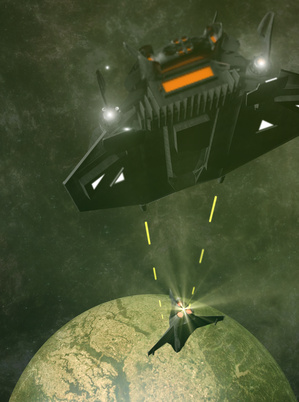Paperbacks!
December 17, 2014Happy Christmas
December 25, 2014The bridge of the Starship Enterprise.
CIC in Babylon 5.
The Millennium Falcon’s gun blister that Luke uses to shoot down pursuing TIE fighters in Star Wars.
And while we’re at it: Flash Gordon’s fizzing cigar tube rocket ship, the TARDIS control room, the entirety of Battlestar Galactica.
These locations have been the backdrop to some perfect moments of science fictional movies and TV, but that’s not all that connects them.
There’s something so fundamental that it affects every single aspect of the set layout, of the way the characters move… So basic that it’s easy to forget.
Gravity.
All the locations have an up and a down. Not only that but down is always pointing in the same direction, no matter the direction in which the engines are thrusting.
Now think of real footage of astronauts in orbit. Skylab, the ISS, Soyuz, space shuttle etc. I’m thinking space walks high above the blue-white planet below, pencils float in the air, grinning astronauts floating past, or running around in human hamster wheel to combat muscular and bone atrophy.
Astronauts in real spacecraft are weightless (sort of… see below…). But real film sets have gravity. That’s why film and TV set designers have little choice but to ignore some basic science, or hand wave it away with some guff about artificial gravity.
Questioning where the gravity comes from on the Millennium Falcon is like asking why Luke and Han Solo speak late twentieth-century North American English. It makes absolutely no sense for them to speak that way, but it’s one of those quiet cheats, a collusion between us and the storyteller so we can enjoy the story to the full. Storytelling is full of these collusions and that’s a good job.
But when it comes to the written word, some of those quiet cheats aren’t necessary, and I feel that to perpetuate them unquestioningly is nothing more than lazy writing. Why do I need gravity inside my spacecraft when I don’t have to build a film set?
Here’s another pair of cheats that make wonderful sense in an audio-visual medium, such as movies, but not with the written word. There is no sound in space, so you can cut those lovely blaster sound from the TIE fighter’s weapons. Lasers and other directed energy beams are directed. That means you can’t see them in space because there’s nothing in the vacuum to scatter or reflect the beam.
I don’t want the film studios to undo the work of drawing in those red and green lines of blaster bolts because if they did, I wouldn’t be able to follow the space battle. But a writer of books has no need of such props.
Back to gravity and getting around our spacecraft. Wishful thinking alone doesn’t create artificial gravity. There is no gravity on a spacecraft in deep space, at least not in the way that we tend to understand it, other than a reaction force experienced when the ship accelerates.
(I’m simplifying here. Real astronauts in orbit, for example, do experience significant gravity, which constantly accelerates them towards the Earth’s center. They aren’t weightless either. Freefall would be a better description of why those pencils float around.)
In my Human Legion books I cheat and bypass some awkward science. I’m not perfect, but I try not to be lazy and copy the bad science of TV that doesn’t need to apply to the written page.
As a reader, I love it when other authors do that. It gives a sense of believability and also freshness.
For example, we’ve all seen space fighters dogfighting in the movies in what is essentially a shinier version of World War Two aerial combat. Looks great, but doesn’t make any sense. You can’t bank, climb or dive in a vacuum because there is no fluid medium to channel changes of momentum. And why bother getting on your opponent’s tail anyway? It’s far easier to pivot your craft through 180 degrees and shot the baddie on your tail than it is to bank out of the way. I saw exactly that happen in Babylon 5, which was an example of the fresh writing that made B5 so good.
I find it far more interesting to read stories where space fighters engage in combat in a vacuum, rather than the black-colored sky that some science fiction writers use to substitute for the vacuum of space.
Now I’m sure I’m doing some of my peers a disservice. Just as the movie director asks for cherry red laser beams, knowing full well they would be invisible in space, so I’m sure some writers calculate that their readers are so trained by films and TV to expect visible laser beams and WW2 dogfights in space, and all that fun nonsense, that they feel they need to dumb down their writing to parrot those clichés.
I’m not trying to set myself up as the super smug clever dick whose writing is superior because the science is right. My writing isn’t accurate, I’m not a scientist, and I do deliberately cheat with the science, but I largely keep my cheating to the background and do so after first considering my options. For me, reading Sci Fi novels that follow the inaccurate clichés of TV carries an extra burden on my suspension of disbelief, and miss an opportunity to make me feel the story is real. I’ve always written stories that I would like someone else to have written first to save me all the bother of having to write them myself. That’s why my stories don’t have visible laser beams, vacuum doesn’t act like air in a dogfight, and ships don’t have gravity without an explanation.
The prompt for me to write this blog post was a chase scene I was writing for Indigo Squad, the second book in the Human Legion series. The chase is set onboard a ship in deep space. How do you chase in a ship without artificial gravity? And now that I’ve written this post, I’ve also added my own little contribution to one of the all-time classic science fiction settings: the space bar. What does a space bar look like in a ship without artificial gravity? Not like a Wild West bar set in space, that’s for sure. Writing novels takes a lot of work; like many writers I am tempted to take short cuts (using the excuse that laziness is an evolutionary successful behavior) and pushing myself to try fitting story to science forces me to freshen up my storytelling.
I hope this post has prompted some thoughts. If I’ve got your brain juiced up, there’s plenty to see on the web about the real science behind science fiction.
One excellent example is the Project Rockets site. It’s with trepidation that I put this link as I’m sure I’ve got plenty of science and engineering wrong. And for a wider look at science fiction tropes in TV and books (despite the site name), try TVtropes.com, such as this page on military sf. Mmm. I recognize some of that list.







1 Comment
Why not just accept that the science works in YOUR universe because you’re its GOD, IT’S CREATOR, IT’S DIETY? Therefore you can do whatever fits the story, as long as you explain the science! And since so much of what we know if as possible vs impossible is changing, you might even become the visionary who starts a new scientific endeavor!!